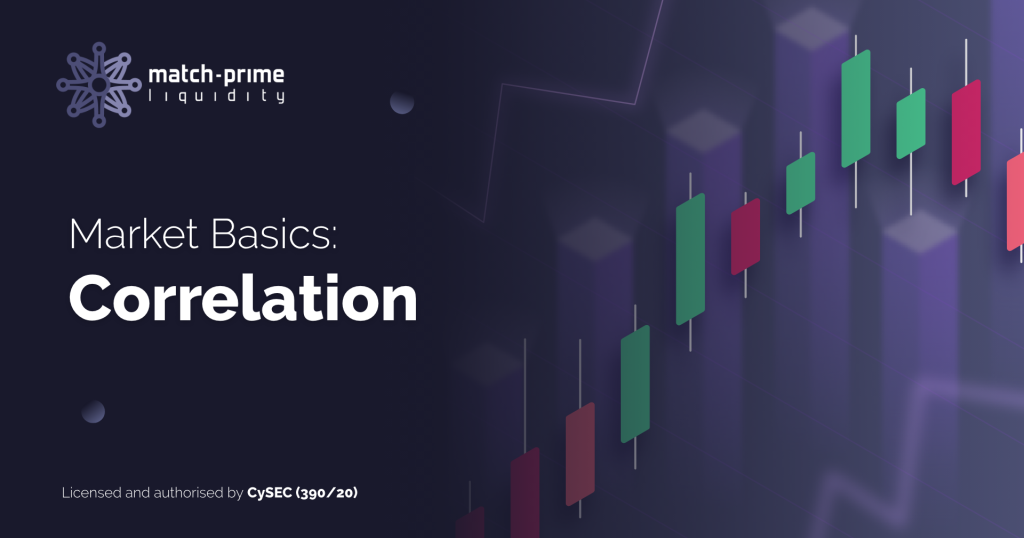The Forex market is a complex and dynamic financial marketplace where currencies are traded against one another. As traders and investors strive to make informed decisions in this high-stakes environment, understanding some of the concepts becomes crucial. We believe that one of these concepts is Correlation, so we decided to take a closer look at it in today’s “Market Basics” article.

Correlation in the Forex market refers to the statistical relationship between the price movements of different currency pairs. By comprehending these interconnected relationships, traders can better gauge potential market movements and manage their risk more effectively.
Understanding Correlation
No currency exists in isolation, especially in the forex market. Currencies are influenced by a myriad of factors, including economic indicators, geopolitical events, central bank policies, and market sentiment. The intricate web of these factors creates relationships between currency pairs that can be measured through correlation.
Correlation is often expressed as a coefficient ranging between -1 and +1. A correlation coefficient of +1 indicates a perfect positive correlation, meaning that the two currency pairs move in the same direction at the same time. Conversely, a correlation coefficient of -1 signifies a perfect negative correlation, implying that the two currency pairs move in opposite directions. A correlation coefficient close to 0 implies a weak or no correlation, suggesting that the price movements of the two currency pairs are relatively independent of each other.
Types of Correlation
Positive Correlation
When two currency pairs have a positive correlation, they tend to move in the same direction. This suggests that when one currency pair appreciates, the other is also likely to appreciate. Positive correlations can arise due to common economic factors or market sentiment. For instance, the Australian Dollar (AUD) and the New Zealand Dollar (NZD) often exhibit positive correlation due to their similar economic ties and geographic proximity.

Negative Correlation
A negative correlation indicates that two currency pairs move in opposite directions. When one currency pair appreciates, the other tends to depreciate. Negative correlations can stem from factors such as divergent monetary policies or economic conditions. An example is the relationship between the USD/JPY (US Dollar/Japanese Yen) and USD/CHF (US Dollar/Swiss Franc), which often exhibit a negative correlation due to the “safe-haven” nature of the Yen and Franc.

No Correlation
When two currency pairs have little to no correlation, their price movements are relatively independent of each other. This implies that trading decisions for one pair are less likely to be influenced by the movements of the other. For instance, EUR/USD (Euro/US Dollar) and AUD/JPY might exhibit little correlation due to the disparate economic drivers of the Eurozone and Australia.

Utilizing Correlation in Forex Trading
Understanding correlation can provide valuable insights to traders. Here are some ways traders can leverage correlation analysis:
Diversification
Correlation analysis aids in diversifying a trading portfolio. By selecting currency pairs with low or negative correlation, traders can potentially reduce risk exposure as losses in one pair may be offset by gains in another.
Risk Management
Traders can use correlation to manage risk by avoiding over-concentration in highly correlated pairs. If multiple positions are taken in positively correlated pairs, losses can be magnified if the market moves against them.
Confirmation of Signals
Correlation analysis can help confirm trading signals. If a trader identifies a strong signal in one currency pair, checking its correlation with another pair can provide additional confidence in the trade.
Hedging Strategies
Corporations engaged in international trade can use currency correlation to design hedging strategies. A company exposed to currency risk can hedge against adverse movements by taking positions in negatively correlated currency pairs.
Correlation Examples
EUR/USD and GBP/USD: These two pairs are positively correlated because the Euro and the British pound are both major currencies that are closely linked to the US dollar. The euro is the second most traded currency in the world, and the British pound is the fourth most traded currency. Both currencies are often used as a proxy for the US dollar, and they tend to move in the same direction when the US dollar is strong or weak.
USD/CHF and EUR/USD: These two pairs are negatively correlated because the Swiss franc is often used as a safe-haven currency, and when there is uncertainty in the market, investors tend to buy Swiss francs. This leads to a decrease in the value of the USD/CHF. The euro, on the other hand, is not seen as a safe-haven currency, and it tends to lose value when there is uncertainty in the market.
USD/JPY and S&P 500: These two pairs are positively correlated because the US dollar is often used as a proxy for the US economy, and the S&P 500 is an index that measures the performance of the top 500 companies listed on the US stock exchange. When the US economy is doing well, the US dollar tends to appreciate, and the S&P 500 tends to go up.
AUD/USD and NZD/USD and Crude Oil: These two pairs are positively correlated because the Australian dollar and the New Zealand dollar are both commodity currencies, and their prices are often affected by the same factors, such as changes in oil prices. When the price of oil goes up, the value of the Australian dollar and the New Zealand dollar tends to go up as well.
USD/CAD and Crude Oil: These two pairs are negatively correlated because the Canadian dollar is often used as a proxy for the price of oil, and when the price of oil goes up, the value of the Canadian dollar tends to go down. This is because when the price of oil goes up, it makes it more expensive for Canada to import oil, which leads to a decline in the value of the Canadian dollar.
Conclusion
Correlation is a fundamental concept in the Forex market that enables traders to understand the relationships between currency pairs and make more informed trading decisions. Positive, negative, and no correlations offer insights into potential market movements and risk exposure. By incorporating correlation analysis into their trading strategies, Forex traders can navigate the complexities of the market with greater confidence and precision. However, it’s important to note that correlation is not a static concept and can change due to shifting market dynamics, making continuous analysis and adaptation essential for successful trading.

